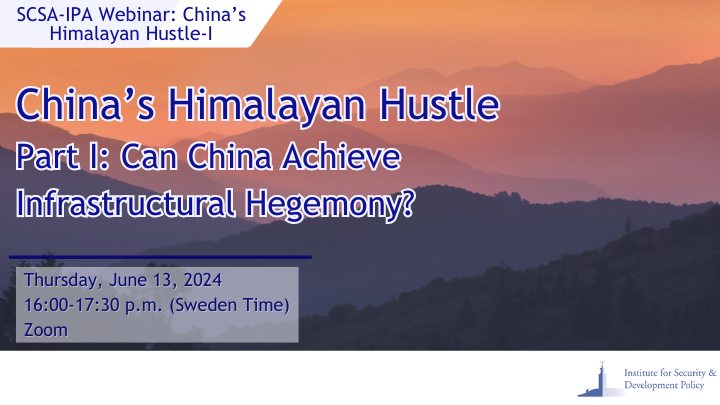China’s Himalayan Hustle – Part I: Can China Achieve Infrastructural Hegemony?

Did you miss this webinar? The full recording is available on ISDP’s YouTube channel.
Of late, China’s growing military, territorial, and diplomatic aggression in the Indo-Pacific has been receiving widespread international attention, particularly its intimidation tactics in the Taiwan Strait and the “salami slicing” in the South China Sea. Unsurprisingly, Chinese attempts to alter the region’s status quo by claiming almost the entirety of the South China Sea (SCS), for example, via re-drawing maps featuring a new 10-dash line combined with military aggression (e.g., creating floating barriers in the resources-rich SCS and building numerous artificial islands) have concerned all Indo-Pacific stakeholder countries, including Australia, European Union (EU), India, Japan – which is also battling China’s “illegal” intrusions in the disputed East China Sea (ECS) – and the US, besides the Southeast Asian SCS claimant states like the Philippines and Vietnam.
Naturally, such attempts are not limited to the maritime regions but extend to the Himalayas. China’s passing of the new Maritime Law and the China Coast Guard Law, as well as the Land Borders Law in the same year, namely 2021, reiterates China’s aggressive purposefulness in pursuing its territorial claims via controversial policymaking in the extended neighborhood.
Notably, in the Himalayan region, the 2017 Doklam stand-off in the tri-junction between Bhutan, China, and India and the 2020 bloody conflict in the Galwan Valley in Ladakh in the western sector of the de facto frontier between India and China (famously known as the Line of Actual Control or LAC) exemplified the impact of China’s military intrusions into the Himalayan neighbors’ territories. Satellite imagery has clearly highlighted China’s infrastructure building particularly near the China-Bhutan border (e.g., construction of roads, military bunkers, and new Chinese villages).
Reportedly, troops belonging to China’s People’s Liberation Army (PLA) are also stationed near some remote Bhutanese territories, which could be in the process of being grabbed by China. Claims by China such as territory in a wildlife sanctuary in Bhutan since 2020; or via a new map in 2023 claiming the Indian state of Arunachal Pradesh and the disputed Aksai-Chin (originally belongs to India) plateau in Chinese territory have continuously raised newer concerns about Beijing pushing its Himalayan land-grab agenda.
At the same time, China has been investing heavily in its restive provinces of the Tibet Autonomous Region (TAR) and Xinjiang Uygur Autonomous Region (XUAR), which share an international border with India. Since 2013, the Chinese government has redirected large investments, particularly through President Xi Jinping’s humongous Belt and Road Initiative (BRI), as part of its “Go West” program (which began in 2001) that includes expanding railway networks, building arterial highways, upgrading state and provincial highways, as well as dual-use or military facilities like airports, and building oil pipelines and water reservoirs. Reportedly, ambitious plans are also afoot to build a new railway line connecting Xinjiang and Tibet that will run close to the LAC and through the disputed Aksai Chin region. The intent is therefore not just to boost development in troubled regions but primarily to facilitate logistical access to its burgeoning military facilities near the borders.
In addition, Chinese BRI investments in Nepal and Pakistan, among other Central Asian states, have garnered concerns about the extent and scope of Chinese economic might in this region. Little wonder then, China’s rapid infrastructure building, including lawfare tactics such as redrawing of maps and constant intrusions, be it the ECS, SCS, Arunachal Pradesh, or Ladakh, as geopolitical territorial aggression has been making global headlines in recent years. However, the international ramifications of this infrastructure onslaught in the Himalayas often seem lacking from the discourse. In addition, China’s blatant disregard for not just neighborliness but also international codes of conduct in terms of territorial sovereignty and rule of law makes it imperative that the Himalayan concerns are addressed more deeply.
Importantly, the Indo-Pacific construct has grown wider traction beyond the US and its Quad partners in the last few years: The EU (2021) followed its member states of France (2018, updated in 2022), Germany (2020), and the Netherlands (2020) in launching the EU’s own “Strategy for Cooperation in the Indo-Pacific.” And soon after, other EU members like the Czech Republic (2022) and Lithuania (2023) embraced their own respective strategies too. But will the wider global community be looking to work together on the Himalayan issues in particular?
This webinar organized by the Stockholm Center for South Asian and Indo-Pacific Affairs (SCSA-IPA) involving China specialists from Europe, the United States, and South Asia aims to examine the extent of the Chinese investments and reach in infrastructure building in the Himalayan region. It aims to explore China’s Himalayan strategy through its forays in neighboring territories to understand its long game in the region. And whether China can ultimately achieve its revisionist aims in the Himalayas. For such a purpose, this first webinar in a series involving some eminent experts on the subject aims to address the following questions:
- How does the Himalayan region factor into China’s contemporary neighborhood policy?
- What is the scope of China’s economic investments, including the BRI, in the Himalayan valley?
- What is China’s current infrastructural development plan in the Himalayan valley?
- How has the recently concluded “Two-Sessions” covered China’s Himalayan strategy on infrastructure development?
- What are the Western perspectives (both in the US and Europe) on China’s infrastructure development plan in the Himalayan region?
- What is the level of awareness about this region in the West, as compared to the maritime regions of the Indo-Pacific such as the Taiwan Strait and the SCS?
- What are the Indian perspectives on China’s infrastructure development plan in the Himalayan region?
- Is there a context for the West and India to create a cooperation strategy against Chinese infrastructural hegemonic aims in the Himalayas? If yes, how?
Panelists:
 Mr. Matej Šimalčík is the Executive Director of the Central European Institute of Asian Studies, a think tank that focuses on foreign and security policy issues related to East Asia. Matej’s research looks at China’s economic and political presence and influence in Central Europe, elite relations, corrosive capital, and the role of European legal instruments in mitigating risks posed by China. In 2022, he founded the China-Europe Academic Engagement Tracker project, which aims to bring transparency to research collaborations with Chinese entities. He has a background in Law (Masaryk University, 2015) and International Relations (University of Groningen, 2016). He is also a senior associate at the Slovakia-based law firm Nechala and partners. Before that, Matej gained experience as an in-house legal counsel for the Slovak branch of Transparency International, a global anti-corruption watchdog, and several Slovak and Czech law firms. In 2021, he was listed on the Forbes 30 Under 30 list (Slovak edition) in the Governance and Social Innovation category. He is also a member of the Expert Pool at the European Center of Excellence for Countering Hybrid Threats (Hybrid CoE); the European Think-tank Network on China; and a country reporter at the CELIS Institute, a think tank focused on investment and economic law.
Mr. Matej Šimalčík is the Executive Director of the Central European Institute of Asian Studies, a think tank that focuses on foreign and security policy issues related to East Asia. Matej’s research looks at China’s economic and political presence and influence in Central Europe, elite relations, corrosive capital, and the role of European legal instruments in mitigating risks posed by China. In 2022, he founded the China-Europe Academic Engagement Tracker project, which aims to bring transparency to research collaborations with Chinese entities. He has a background in Law (Masaryk University, 2015) and International Relations (University of Groningen, 2016). He is also a senior associate at the Slovakia-based law firm Nechala and partners. Before that, Matej gained experience as an in-house legal counsel for the Slovak branch of Transparency International, a global anti-corruption watchdog, and several Slovak and Czech law firms. In 2021, he was listed on the Forbes 30 Under 30 list (Slovak edition) in the Governance and Social Innovation category. He is also a member of the Expert Pool at the European Center of Excellence for Countering Hybrid Threats (Hybrid CoE); the European Think-tank Network on China; and a country reporter at the CELIS Institute, a think tank focused on investment and economic law.
 Mr. Jeffrey Payne currently serves as an Assistant Professor at the Near East South Asia (NESA) Center for Strategic Studies in Washington DC, USA. He pilots NESA’s maritime security programming, including its ongoing series devoted to the Indian Ocean Region and wider Indo-Pacific. In addition, he leads NESA’s engagements relating to maritime information sharing/data analysis. Mr. Payne analyzes Chinese foreign policy, Indian Ocean Regional affairs, and maritime security. He is particularly interested in the intersection of maritime security and strategic competition in the Indian Ocean, as well as how technology and information can assist in furthering security cooperation. His work informs United States Combatant Commands, the Office of the Secretary of Defense, and interagency efforts inside the United States government.
Mr. Jeffrey Payne currently serves as an Assistant Professor at the Near East South Asia (NESA) Center for Strategic Studies in Washington DC, USA. He pilots NESA’s maritime security programming, including its ongoing series devoted to the Indian Ocean Region and wider Indo-Pacific. In addition, he leads NESA’s engagements relating to maritime information sharing/data analysis. Mr. Payne analyzes Chinese foreign policy, Indian Ocean Regional affairs, and maritime security. He is particularly interested in the intersection of maritime security and strategic competition in the Indian Ocean, as well as how technology and information can assist in furthering security cooperation. His work informs United States Combatant Commands, the Office of the Secretary of Defense, and interagency efforts inside the United States government.
 Dr. Thomas Eder is a Senior Researcher on China, and covers China’s foreign and security policy for the Austrian Institute for International Affairs (OIIP) in Vienna. He primarily focuses on China & major power relations, as well as China & global governance. Before the OIIP, he was a member of the foreign policy team at MERICS in Berlin. He is currently also a Visiting Fellow at the China Observers in Central and Eastern Europe (CHOICE) network, and a lecturer at the University of Vienna.
Dr. Thomas Eder is a Senior Researcher on China, and covers China’s foreign and security policy for the Austrian Institute for International Affairs (OIIP) in Vienna. He primarily focuses on China & major power relations, as well as China & global governance. Before the OIIP, he was a member of the foreign policy team at MERICS in Berlin. He is currently also a Visiting Fellow at the China Observers in Central and Eastern Europe (CHOICE) network, and a lecturer at the University of Vienna.
 Dr. Antonina Łuszczykiewicz, a former Fulbright senior scholar at Indiana University-Bloomington in the United States, served as the founding director of the Taiwan Lab Research Center at the Jagiellonian University in Krakow until February 2023. She is an assistant professor at the Jagiellonian University and a research fellow of the Central European Institute of Asian Studies in Bratislava. Dr. Łuszczykiewicz is the author of over 150 books and book chapters, journal articles, and conference papers on China-India-US relations, Poland-Taiwan relations, and the Cold War history. She was educated and gained her research experience at the Jagiellonian University in Krakow, Xi’an Jiaotong University in China, and the University of Cambridge.
Dr. Antonina Łuszczykiewicz, a former Fulbright senior scholar at Indiana University-Bloomington in the United States, served as the founding director of the Taiwan Lab Research Center at the Jagiellonian University in Krakow until February 2023. She is an assistant professor at the Jagiellonian University and a research fellow of the Central European Institute of Asian Studies in Bratislava. Dr. Łuszczykiewicz is the author of over 150 books and book chapters, journal articles, and conference papers on China-India-US relations, Poland-Taiwan relations, and the Cold War history. She was educated and gained her research experience at the Jagiellonian University in Krakow, Xi’an Jiaotong University in China, and the University of Cambridge.
 Mr. Saroj Kumar Aryal is a researcher at the Faculty of Political Science and International Studies at the University of Warsaw. He is from Nepal. Mr. Aryal has published multiple research articles in high-indexed (Q1, Q2) SCOPUS-indexed international journals such as Geopolitics, Asian Journal of Comparative Politics, Journal of Contemporary European Studies, Society, and Journal of Asian and African Studies. His areas of interest include India’s foreign policy, South Asia, Security complexities in the Asia-Pacific region, Polarity, and the Rise of the Global South in the International System. He has been part of many international conferences including Binghamton University, New York, Dublin City University, Dublin, Syracuse University, Syracuse, Charles University, Prague.
Mr. Saroj Kumar Aryal is a researcher at the Faculty of Political Science and International Studies at the University of Warsaw. He is from Nepal. Mr. Aryal has published multiple research articles in high-indexed (Q1, Q2) SCOPUS-indexed international journals such as Geopolitics, Asian Journal of Comparative Politics, Journal of Contemporary European Studies, Society, and Journal of Asian and African Studies. His areas of interest include India’s foreign policy, South Asia, Security complexities in the Asia-Pacific region, Polarity, and the Rise of the Global South in the International System. He has been part of many international conferences including Binghamton University, New York, Dublin City University, Dublin, Syracuse University, Syracuse, Charles University, Prague.
Moderator:
 Dr. Jagannath Panda is the Head of the Stockholm Center for South Asian and Indo-Pacific Affairs at the Institute for Security and Development Policy, Sweden. He is a Professor at the Department of Regional and Global Studies at the University of Warsaw, and a Senior Fellow at The Hague Center for Strategic Studies (HCSS) in the Netherlands and an International Research Fellow at the Canon Institute for Global Studies in Japan. Dr. Panda has testified to the US-China Economic and Security Review Commission at the US Congress. He is also the Series Editor for Routledge Studies on Think Asia.
Dr. Jagannath Panda is the Head of the Stockholm Center for South Asian and Indo-Pacific Affairs at the Institute for Security and Development Policy, Sweden. He is a Professor at the Department of Regional and Global Studies at the University of Warsaw, and a Senior Fellow at The Hague Center for Strategic Studies (HCSS) in the Netherlands and an International Research Fellow at the Canon Institute for Global Studies in Japan. Dr. Panda has testified to the US-China Economic and Security Review Commission at the US Congress. He is also the Series Editor for Routledge Studies on Think Asia.